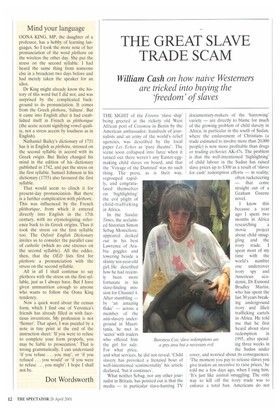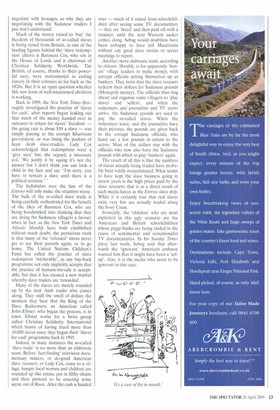THE GREAT SLAVE TRADE SCAM
William Cash on how naive Westerners
are tricked into buying the ,freedom' of slaves
THE SIGHT of the Etireno 'slave ship' being greeted at the rickety old West African port of Cotonou in Benin by the American ambassador, hundreds of journalists and an army of the world's relief agencies, was described by the local paper Les Echos as 'pure theatre'. The scene soon collapsed into farce when it turned out there weren't any Easter-eggmaking child slaves on board, and that the 'Voyage of the Damned' was no such thing. The press, as is their way, regrouped rapidly, and congratulated themselves on 'highlighting' the evil plight of child-trafficking in Africa.
In the Sunday Times, the acclaimed historian Simon Sebag Montefiore, appeared decked out in his best Lawrence of Arabia goggles and towering beside a skinny ten-year-old girl. He described how he had recently been more fortunate in his slave-finding mission for Channel 4. After stumbling — by 'an amazing fluke' — across a member of the anti-slavery underground in Mauritania, he met in 'secret' with traders who offered him the girl for sale. For what price, and what services, he did not reveal. 'Child slavery has provoked a frenzied bout of well-intentioned sentimentality' his article declared, 'but it continues'.
What neither Sebag, nor any other journalist in Britain, has pointed out is that the media — in particular slave-hunting TV documentary-makers of the 'harrowing' variety — are directly to blame for much of the growing problem of child slavery in Africa; in particular in the south of Sudan, where the enslavement of Christians (a trade estimated to involve more than 20,000 people) is now more profitable than drugs or trading ex-Soviet AK-47s. The problem is that the well-intentioned 'highlighting' of child labour in the Sudan has raised slave prices up to $300 as a result of 'slaves for cash' redemption efforts — in reality, often racketeering — that come straight out of a Graham Greene novel.
I know this because a year ago I spent two months in Africa researching a movie project about child smuggling and the ivory trade. I spent most of my time with the world's number one undercover ivory spy and American academic, Dr Esmond Bradley Martin, who has spent the last 30 years breaking underground ivory and illicit trafficking cartels in Africa. He told me that he first heard about slave redemption in 1995, after spending three weeks in the Sudan under cover, and worried about its consequences. 'The moment you pay to release slaves you give traders an incentive to raise prices,' he told me a few days ago, when I rang him. 'It's just like animal smuggling. The only way to kill off the ivory trade was to enforce a total ban. Americans do not negotiate with hostages, so why they are negotiating with the Sudanese traders I just don't understand'.
Much of the money raised to 'buy' the freedom of thousands of so-called slaves is being raised from Britain, as one of the leading figures behind the 'slave redemption' efforts is Baroness Cox, who sits in the House of Lords and is chairman of Christian Solidarity Worldwide. The British, of course, thanks to their powerful navy, were instrumental in ending slavery in their colonies as far back as the 1820s. But it is an open question whether this new form of well-intentioned abolition is working.
Back in 1999, the New York Times thoroughly investigated the practice of 'slaves for cash', after reports began leaking out that much of the money handed over in suitcases in return for slaves' freedom' — the going rate is about $50 a slave — was simply passing to the corrupt Khartoum government, or was lining the pockets of hoax Arab slave-traders. Lady Cox acknowledged that redemptions were a 'grey area' but, she argued, a necessary evil. 'We justify it by saying it's not the answer but I don't think you can look a child in the face and say: "I'm sorry, you have to remain a slave until there is a political solution." ' The hullabaloo over the fate of the Etireno will only make the situation worse. The bulk of the so-called slave trade is being carefully orchestrated for the benefit of the likes of Baroness Cox, who are being hoodwinked into thinking that they are doing the Sudanese villagers a favour; when in fact, as the New York Times and Atlantic Monthly have both established without much doubt, the pernicious truth is that many of the 'released' slaves never get to see their parents again, or to go home. The United Nations Children's Fund has called the practice of slave redemption 'intolerable', as any buy-back programme not only implicitly accepts that the practice of humans-for-sale is acceptable, but that it has created a new market whereby slave traders are 'rewarded'.
Many of the slaves are merely rounded up by the next Arab trader who comes along. They sniff the smell of dollars the moment they hear that the King of the Slave Redeemers, an American called John Eibner, who began the process, is in town. Eibner works for a Swiss group called Christian Solidarity International which boasts of having freed more than 10,000 slaves since they began their 'slaves for cash' programme back in 1995.
Indeed, in many instances the so-called 'slave trade' is no more than an elaborate scam. Before 'fact-finding' television documentary makers, or do-good American slave rescuers, or Lady Cox, come to a village, hungry local women and children are rounded up like extras, put in filthy chains and then pretend to be enacting some scene out of Roots. After the cash is handed
over — much of it raised from schoolchildren after seeing some TV documentary — they are 'freed' and then paid off with a retainer, until the next Western sucker comes along. Sebag would doubtless have been unhappy to have left Mauritania without any good slave stories or secret meetings to report.
Another more elaborate scam, according to Atlantic Monthly, is for apparently 'honest' village leaders to make money, with corrupt officials setting themselves up as bankers. They insist that the slave rescuers redeem their dollars for Sudanese pounds (Monopoly money). The officials than ring ahead and organise some villagers to 'play slaves' and 'sellers', and when the redeemers and journalists and TV crews arrive, the Sudanese pounds are used to pay the so-called slaves. When the redeemers leave, and the journalists have their pictures, the pounds are given back to the corrupt Sudanese officials, who hand out a few pounds in return to the actors. Most of the dollars stay with the officials who now also have the Sudanese pounds with which to play 'bankers' again.
The result of all this is that the numbers of slaves actually being traded have probably been wildly overestimated. What seems to have kept the slave business going in recent years is the high prices paid by the slave rescuers; that is as a direct result of such media farces as the Etireno slave ship. While it is certainly true that real slaves exist, very few are actually traded along the Ivory Coast.
Ironically, the 'children' who are most exploited in this ugly scenario are the American and British schoolchildren whose piggy-banks are being raided in the cause of sentimental and sensationalist TV documentaries. In his Sunday Times piece last week, Sebag said that afterwards the 'ignorant' American embassy warned him that it might have been a 'setup'. Alas, it is the media who seem to be ignorant in this case.



































































 Previous page
Previous page